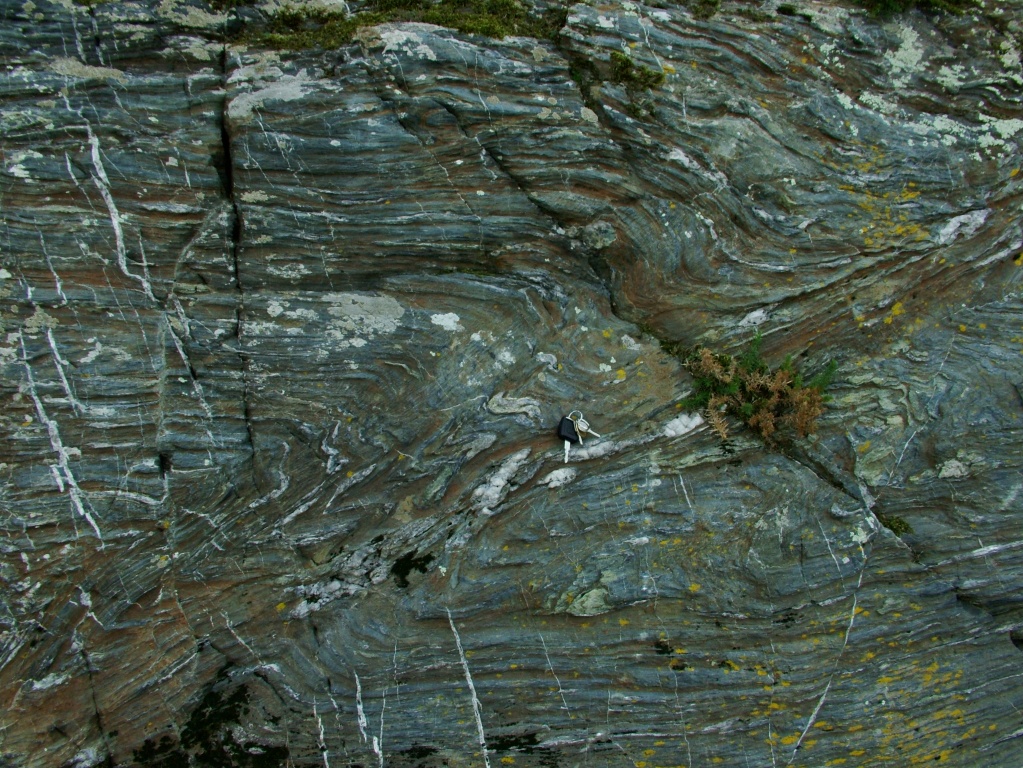Highly
deformed blueschist
©
R.
Roberts, CCW
What
is ‘special’ about the geology at Sgistiau Glas
Ynys
Môn SSSI?
Sgistiau
Glas Ynys Môn SSSI has one special
feature:
· Precambrian blueschist exposed
in disused quarries, inland outcrops and road cuttings.
Sgistiau Glas Ynys Môn is of special scientific
interest because the
rocks contain a rare assemblage of blue
amphibole-bearing minerals which were formed under high-pressure and
low-temperature.
These rocks, which are Precambrian in age (over 550 million years old),
include
the best and most accessible exposures of blueschist in Great
Britain and are one of the
oldest known examples of this rock type in the world. Blueschists are
typically
formed at oceanic plate margins where one plate slides beneath another,
a
process known as subduction. Rocks in the cold descending plate are
buried
quickly and subjected to very high pressure whilst still remaining at
relatively low temperature. These physical conditions are responsible
for
formation of the amphibole minerals and which in turn provides
important
information concerning the geology of the area.
What
do
we want Sgistiau Glas Ynys Môn SSSI to look like?
The
following is a description of how we would
like to see the feature at Sgistiau Glas Ynys Môn SSSI:
Our
aim
for this site will be focussed on maintaining the current high level of
rock
exposure throughout the site, as well as keeping all rock faces visible
and
accessible. In seeking to achieve our aim, we will thereby ensure that
the Sgistiau
Glas Ynys Môn SSSI
will continue to provide a key locality for research into Precambrian
geology.
What management is needed at Sgistiau Glas Ynys
Môn SSSI and why?
Sgistiau
Glas Ynys Môn SSSI is
an
internationally important locality for studies of Precambrian geology
and sites
such as this are vital for further geological research. However it will
only
remain so if the necessary management continues and CCW’s
priority is to work
with you to ensure that this management is carried out.
What
does this mean in practice?
There
are a number of different factors that could damage
the special feature at Sgistiau
Glas Ynys Môn SSSI if
they are not properly managed. These are the ones we regard as most
important:
Visibility
Any activities that might obscure the natural
rock exposures, for
example civil engineering works such as rock netting or shotcrete, the
dumping
of earth, spoil or other waste materials, and the construction of farm
buildings on or against rock outcrops, must be avoided. Operations
which might
be undertaken for safety reasons could also result in the concealment
of these
important exposures. Therefore, a close liaison will be maintained
between CCW
and the landowners.
Accessibility
Periodically, students and researchers may need
access to study the rock
exposures at this site. However, there is no public access to the crags
at
Castellior Farm or the cutting on the A55. Therefore, access is
entirely at the
discretion of the landowners. Even though the crags surrounding the
Marquess of
Anglesey’s Column form part of a visitor attraction, all
necessary permissions
should be sought before undertaking any research on the rock exposures.
Agricultural practices
Current
agricultural
practices, namely animal grazing, have little or no effect upon the
feature of
geological interest.
Finally
Our knowledge and understanding of geology
is continually improving. It
is possible
that new issues may arise in the future, whilst other issues may
disappear. This
statement is written with the best
information we have now, but may have to change in the future as our
understanding improves. Any information you can provide on the geology
of your
site, its management and its conservation would be much appreciated.
If you
would like to discuss any aspect of your SSSI, or have any concerns
about your
SSSI, please contact your local CCW office.
CCW
Llys y Bont
Ffordd y Parc
BANGOR
Gwynedd
LL57 4BN
Telephone:
01248 672500
Fax:
01248
679259
Web
site:
http://www.ccw.gov.uk
